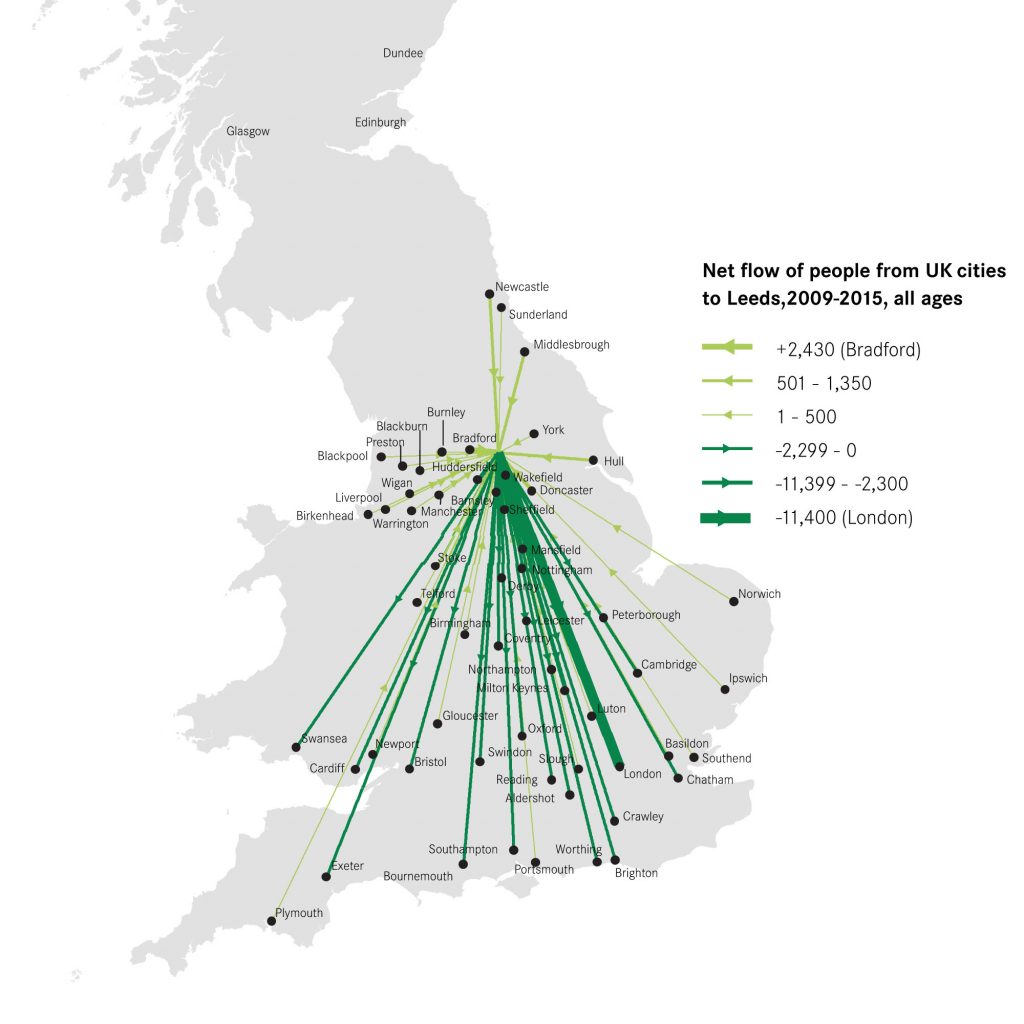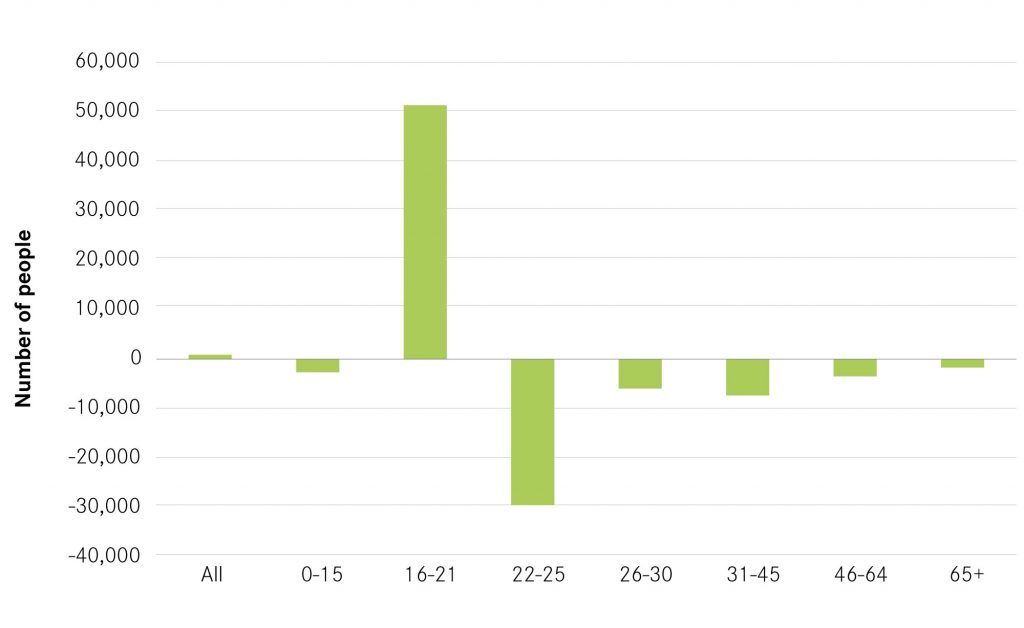01The nature of migration between Leeds and the rest of England and Wales
This section combines migration data from the ONS and the Census to look at migration to and from Leeds by age and qualification.
Most migration is between Leeds and the rest of Yorkshire and the Humber
Between 2009 and 2015 250,500 people moved into Leeds from England and Wales and 249,600 moved out. The resulting net inflow to the city was just 900 people, which is small compared with the net flows seen by other UK cities. Bournemouth experienced the largest net inflow of 15,100 people and London the largest net outflow of 340,300 people.
Most migration was between Leeds and the rest of Yorkshire. Between 2009 and 2015, 38 per cent of inward migration was from Yorkshire and the Humber and 39 per cent of outward migration was to Yorkshire and the Humber. However, overall there was a small net outflow to the region, as shown in Figure 1. To all other regions except London there were net inflows, the largest of which was from the North West; Leeds gained 4,400 people from this region.
There was also significant migration between Leeds and London. There was a large net outflow to London, equal to 11,400 between 2009 and 2015. The capital was the most popular city destination of those leaving Leeds with 34,900 moving there, as shown in Figure 2. It was also the most popular city origin of those moving to Leeds, with 23,500 people arriving from London over the period.
In addition, there was a considerable amount of local migration between Leeds and Bradford: 21,900 moved into Leeds from Bradford, and 19,400 moved to Bradford from Leeds. Given their proximity to each other many of these migrants may live in one city and work in the other.
Leeds gains young people and loses older people
The city’s migration patterns varied greatly by age. Figure 3 shows how the movement of young people dominates the city’s migration patterns. Despite only accounting for 10 per cent of the population, 16 to 21 year olds accounted for 39 per cent of inward migration. Similarly, 22 to 25 year olds accounted for 7 per cent of the population but 29 per cent of outward migration.
Outward migration became more common than inward migration for older age groups. Those aged 26 to 30 accounted for 15 per cent of outward migration and only 7 per cent of the population. The scale of migration reduced with age: for all age groups 31+ their share of the city’s population outweighed their share of either form of migration.
Overall, all age groups experienced a net outflow from Leeds, as shown in Figure 4, except for 16 to 21 year olds. This net inflow was equal to 51,300 young people entering the city.
Leeds loses degree holders, first to the southern regions and second to the rest of Yorkshire
While the qualifications of migrants are not available in the ONS data, the 2011 Census provides us with this information for movers between 2010 and 2011. When the data is split into three age groups: 16 to 21, 22 to 30, and 31 to 45 year olds, three distinct trends emerge.
There was a net inflow of 16 to 21 year olds to Leeds from all regions, the largest of which were from the North West and Yorkshire, as shown in Figure 5. These migrants predominantly had A-Level qualifications or equivalent, pointing to the pull of the city’s universities, which will be discussed in greater detail in the next section. Of the 16 to 21 year olds moving into Leeds, 78 per cent had A-Level qualifications, compared with 59 per cent of those leaving the city.
The net outflow of 22 to 30 year olds was dominated by degree holders. The majority of this age group who decided to leave Leeds had a degree, 67 per cent, compared with 59 per cent of 22 to 30 year olds moving into the city.
The most popular destination of this age group was London; 20 per cent of those who left Leeds went to the capital. The second most popular city destination was Bradford, with 7 per cent of 22 to 30 year olds leaving the city moving there. Figure 6 shows that there was a net outflow of these graduates to every region, except Yorkshire and the North East. Therefore, whilst Leeds lost graduates to regions further south, it saw a brain gain from these two areas.
To look in more detail at this brain gain, the wider migration data for 2009 to 2015 allows us to look at movements between local authorities and so track movements within Yorkshire. There were net inflows into the city of 22 to 30 year olds from both York and Bradford local authorities. In contrast, there were net outflows to Wakefield, Selby, Harrogate and Huddersfield, but these were not large enough to outweigh the net inflows from the region.
The second wave of degree holders leaving Leeds was of those aged 31 to 45; however the geography of this net outflow was different. The majority of movers stayed within the region instead of moving further afield, as Figure 7 shows. As well as moving elsewhere within Yorkshire, there was also a net outflow of these graduates to the North West.
Looking again at the wider migration data for 2009 to 2015 allows us to look at movements between local authorities and so track movements within Yorkshire. This shows that most of these older leavers remained close to the city. Harrogate and Wakefield gained, on a net basis, the largest number of those leaving Leeds (970 and 740 respectively) and the next most popular destinations were Selby (650) and Huddersfield (510). These movers therefore remained within a commutable distance of Leeds, even if they no longer lived there, and many will still contribute to the high-skilled workforce of the city. Meanwhile, there was also a net inflow of 31 to 45 year olds to the city from a few neighbouring local authorities: 330 from Bradford and 180 from Hull.
Figure 7 also shows that the city lost older graduates to London and the South East; the outflow to the capital described above for young graduates continued as they aged. Once again, looking at the local authority level data gives a more nuanced picture. Whilst Leeds saw a net outflow of 31 to 45 year olds, some other local authorities in Yorkshire saw a net inflow of this age group from London. There was a net inflow of 430 to Harrogate, 100 to Huddersfield, and 60 to Wakefield. Therefore, older people do return to Yorkshire but move straight to smaller towns and the surrounding areas rather than to the city of Leeds.
This trend is common to many UK cities who find that their older high-skilled workers move out for a change of lifestyle, but don’t move far and often still commute into the city for work. Those aged between 35 and 55 tend to place more value on the size and type of their house and access to local schools, leading many to prefer living outside the city centres.2
Summary
- Overall Leeds experienced a small net inflow to the city between 2009 and 2015.
- This net inflow was driven by those aged 16 to 21. Many of these are likely to have been students going to university, which is explored in the next section.
- The city experienced a net outflow of older people with degrees. First, there was a net outflow of graduates aged between 22 and 30 moving predominantly to London. Second, there was a net outflow of graduates aged 31 to 45. Although some of these older graduates moved to London, most chose instead to remain within the Yorkshire region.







